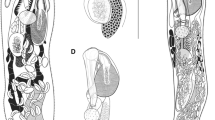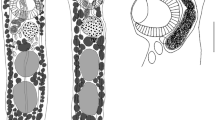Abstract
Phylogenetic relationship reconstruction and taxonomical analysis of trematodes of the genus Bunodera was carried out using 28S rDNA partial sequences along with a description and molecular characterisation of a new species, B. vytautasi sp. nov. A new species is reported from the intestine of Pungitius pungitius (Linnaeus, 1758), collected from Magadan Region, Russia. The diagnostic characters of B. vytautasi sp. nov. are the extension of vitelline fields from the oral sucker or posterior edge of the pharynx to the posterior extremity of the body, the confluence of vitelline fields within the forebody, the extension of the cirrus-sac to the posterior third of ventral sucker or further backwards with an outlet beyond the posterior edge of the sucker, and the presence of a unipartite internal seminal vesicle. Both Bayesian and Maximum Likelihood trees shared the same tree topology, in which the genus Bunodera was shown to be monophyletic. Representatives of the genus Bunodera were distributed into three well-supported clades: percid-infecting species (Eurasian species B. luciopercae and B. acerinae and North American B. luciopercae s.l.), gasterosteid-infecting species (amphi-Pacific B. mediovitellata and North American B. inconstans and B. eucaliae) and percid/gasterosteid-infecting species (Asiatic B. vytautasi sp. nov. and North American B. sacculata). Eurasian B. luciopercae and B. acerinae were more closely related to each other than to North American B. luciopercae s.l.




Similar content being viewed by others
References
Akaike H (1974) A new look at the statistical model identification. IEEE Trans Autom Control 19:716–723. https://doi.org/10.1109/TAC.1974.1100705
Atopkin DM, Shedko MB (2014) Genetic characterization of far eastern species of the genus Crepidostomum (Trematoda: Allocreadiidae) by means of 28S ribosomal DNA sequences. Adv Biosci Biotech 5:209–215. https://doi.org/10.4236/abb.2014.53027
Atrashkevich GI, Orlovskaya OM, Regel KV, Mikhailova EI, Pospekhov VV (2005) Parasitic worms from Taui Bay. In: Chereshnev IA, Chernyavsky FB, Kashin VA (eds) Biological diversity of Taui Bay of the Sea of Okhotsk. Dalnauka Press, Vladivostok, pp 175–251 (In Russian)
Barskaya YY (2001) Structure and diversity of parasite communities of grayling (Thymallus thymallus) from the River Olanga. In: Ieshko EP (ed) Eco-parasitological research on animals and plants in the Europe. Karelian Research Centre of RAS, Petrozavodsk, pp 36–39 (In Russian)
Brooks DR (1992) New distribution records for Bunodera eucaliae and B. inconstans n. comb. (Digenea: Allocreadiidae: Bunoderinae) with discussion of their phylogenetic relationships. J Parasitol 78:779–783. https://doi.org/10.2307/3283303
Caira JN (1989) A revision of the North American papillose Allocreadiidae (Digenea) with independent cladistic analyses of larval and adult forms. Bull Univ Nebr State Mus 11:1–58
Caira JN, Bogéa T (2005) Family Allocreadiidae. In: Jones A, Bray RA, Gibson DI (eds) Keys to the Trematoda, vol 2. CABI Publishing and The Natural History Museum, Wallingford, pp 417–436
Choudhury A, Lèon-Regagnon V (2005) Molecular phylogenetics and biogeography of Bunodera spp. (Trematoda: Allocreadiidae), parasites of percid and gasterosteid fishes. Can J Zool 83:1540–1546. https://doi.org/10.1139/z05-153
Choudhury A, Rosas-Valdez R, Johnson RC, Hoffmann B, Pérez-Ponce de León G (2007) The phylogenetic position of Allocreadiidae (Trematoda: Digenea) from partial sequences of the 18S and 28S ribosomal RNA genes. J Parasitol 93:192–196. https://doi.org/10.1645/GE-966R.1
Curran SS, Tkach VV, Overstreet RM (2011) Phylogenetic affinities of Auriculostoma (Digenea: Allocreadiidae), with descriptions of two new species from Peru. J Parasitol 97:661–670. https://doi.org/10.1645/GE-2641.1
Darriba D, Taboada GL, Doallo R, Posada D (2012) jModelTest 2: more models, new heuristics and parallel computing. Nat Methods 9:772. https://doi.org/10.1038/nmeth.2109
Gibson DI (1996) Trematoda. In: Margolis L, Kabata Z (eds) Guide to the Parasites of Fishes of Canada, part IV. NRC Research Press, Ottawa, pp 1–373
Guindon S, Gascuel O (2003) PhyML: a simple, fast and accurate algorithm to estimate large phylogenies by maximum likelihood. Syst Biol 52:696–704. https://doi.org/10.1080/10635150390235520
Hernández-Mena DI, Lynggaard C, Mendoza-Garfias B, Pérez-Ponce de León G (2016) A new species of Auriculostoma (Trematoda: Allocreadiidae) from the intestine of Brycon guatemalensis (Characiformes: Bryconidae) from the Usumacinta River Basin, Mexico, based on morphology and 28S rDNA sequences, with a key to species of the genus. Zootaxa 4196:261–277. https://doi.org/10.11646/zootaxa.4196.2.5
Hoffman GL (1999) Parasites of north American freshwater fishes, 2nd edn. Cornell University Press, Ithaca
Hopkins SH (1934) The papillose Allocreadiidae. Ill Biol Monogr 13:1–80
Huelsenbeck JP, Ronquist F, Nielsen R, Bollback JP (2001) Bayesian inference of phylogeny and its impact on evolutionary biology. Science 294:2310–2314. https://doi.org/10.1126/science.1065889
Lasee BA, Font WF, Sutherland DR (1988) Culaeatrema inconstans gen. n., sp. n. (Digenea: Allocreadiidae) from the brook stickleback (Culaea inconstans) in Wisconsin and observations on parthenogenetic populations. Can J Zool 66:1328–1333. https://doi.org/10.1139/z88-195
Lockyer AE, Olson PD, Littlewood DTJ (2003) Utility of complete large and small subunit rRNA genes in resolving the phylogeny of the Neodermata (Platyhelminthes): implications and a review of the cercomer theory. Biol J Linn Soc Lond 78:155–171. https://doi.org/10.1046/j.1095-8312.2003.00141.x
Lühe M (1909) Parasitische Plattwürmer. I Trematoden – Süβwasserfische Deutschlands H 17
Muzall PM (2002) Occurrence of Bunodera sacculata Van Cleave and Mueller, 1932 in Perca flavescens from Silver Creek and Silver Lake, Michigan. J Parasitol 88:203–205. https://doi.org/10.1645/0022-3395(2002)088[0203,OOBSVC]2.0.CO;2
Petkevičiūtė R, Stunzenas V, Staneviciute G, Sokolov SG (2010) Comparison of the developmental stages of some European allocreadiid trematode species and a clarification of their life-cycles based on ITS2 and 28S sequences. Syst Parasitol 76:169–178. https://doi.org/10.1007/s11230-010-9249-8
Pospekhov VV, Atrashkevich GI, Orlovskaya OM (2010) Fish parasites from the Gizhiga River basin (northern coast of the Okhotsk Sea). Izv TINRO 163:365–378 (In Russian)
Pospekhov VV, Atrashkevitch GI, Orlovskaya OM (2014) Parasite worms of anadromous salmon fishes from the northern part of the Sea of Okhotsk. Magadan, Kordis (In Russian)
Pugachev ON (1983) Freshwater fish helminths of North-East Asia. Proc Zool Inst USSR AS 181:90–113 (In Russian)
Roitman VA, Sokolov SG (1999) Taxonomic analysis of Bunodera luciopercae (O.F. Müller, 1776). In: Sonin MD (ed) Parasite-host interactions. INPA RAS, Moscow, pp 73–84 (In Russian)
Rumyantsev EA, Ieshko EP, Shulman BS (1999) Parasite fauna formation in the European grayling Thymallus thymallus. Parazitologiya 33:136–143 (In Russian)
Skryabin KI, Koval VP (1966) Family Bunoderidae Nicoll, 1914. In: Skryabin KI (ed) Trematodes of animals and men, vol XXII. Nauka, Moscow, pp 311–456 (In Russian)
Sokolov SG (2010a) The parasites of sticklebacks (Gasterosteidae) from the Utkholok R. area (North-western Kamchatka). Bull NESC FEB RAS 3:56–66 (In Russian)
Sokolov SG (2010b) New data on helminths of juvenile starry flounder Platichthys stellatus (Pallas, 1787) (Osteichthyes, Pleuronectidae) inhabiting Western Kamchatka rivers. Inland Water Biol 3:79–84. https://doi.org/10.1134/S1995082910010104
Sokolov SG, Tseitlin DG, Afanasyev KI, Malinina TV, Rubtsova GA (2006) A comparative study of two sympatric subspecies of trematodes, Bunodera luciopercae luciopercae (Muller, 1776) and B.l. acerinae Roitman and Sokolov, 1999 (Trematoda: Bunoderidae). Invert Zool 3:209–223 (In Russian)
Sokolov SG, Protasova EN, Cherevichko AV (2013) A new taxonomic status of the trematodes Bunodera luciopercae s. str. and B. acerinae stat. n. (Trematoda: Allocreadiidae) and second intermediate host of B. luciopercae s. str. Zoologicheskii Zhurnal 92:184–193. https://doi.org/10.7868/S0044513413020165 (In Russian)
Soldanova M, Georgieva S, Rohacova J, Knudsen R, Kuhn JA, Henriksen EH, Siwertsson A, Shaw JC, Kuris AM, Amundsen PA, Scholz T, Lafferty KD, Kostadinova A (2017) Molecular analyses reveal high species diversity of trematodes in a sub-Arctic lake. Int J Parasitol 47:327–345. https://doi.org/10.1016/j.ijpara.2016.12.008
Stiles CW, Hassall A (1898) Notes on parasites 48.—an inventory of the genera and subgenera of the trematode family Fasciolidae. Arch Parasitol 1:81–99
Tamura K, Stecher G, Peterson D, Filipski A, Kumar S (2013) MEGA6: molecular evolutionary genetics analysis version 6.0. Mol Biol Evol 30:2725–2729. https://doi.org/10.1093/molbev/mst197
Tkach VV, Littlewood DTJ, Olson PD, Kinsella JM, Swiderski Z (2003) Molecular phylogenetic analysis of the Microphalloidea Ward, 1901 (Trematoda: Digenea). Syst Parasitol 56:1–15. https://doi.org/10.1023/A:1025546001611
Truett GE (2006) Preparation of genomic DNA from animal tissues. In: Kieleczawa J (ed) The DNA book: protocols and procedures for the modern molecular biology laboratory. Jones and Bartlett Publisher, Sudbury, pp 33–46
Tsimbaliuk AK, Roitman VA (1966) Trematoda Bunodera mediovitellata (Bunoderidae) from stickleback, Commander Islands. Trudi Gelmintologicheskoi Laboratorii Akad. Nauk SSSR 17:290–296 (In Russian)
Van Cleave HJ, Mueller JF (1932) Parasites of the Oneida Lake fishes. Part 1. Descriptions of new genera and new species. Bull New York State Coll Forest Syracuse Univ 4:5–72
Yamaguti S (1971) Synopsis of digenetic trematodes of vertebrates, vol I. Keigaku, Tokyo
Acknowledgements
Special thanks to Gennady I. Atrashkevich (Institute of Biological Problems of the North, Magadan) and Darya I. Lebedeva and Evgeniy P. Ieshko, Institute of Biology, Karelian Research Centre of the RAS, for material collection.
Funding
This study was supported by Grant of Russian Scientific Foundation, no. 17-74-20074.
Author information
Authors and Affiliations
Corresponding author
Additional information
Section Editor: Shokoofeh Shamsi
Rights and permissions
About this article
Cite this article
Atopkin, D.M., Sokolov, S.G., Shedko, M.B. et al. Diversity of the genus Bunodera Railliet, 1896 (Trematoda: Allocreadiidae) in the northern part of Eastern Europe and North-eastern Asia, estimated from 28S rDNA sequences, with a description of Bunodera vytautasi sp. nov.. Parasitol Res 117, 1765–1772 (2018). https://doi.org/10.1007/s00436-018-5858-y
Received:
Accepted:
Published:
Issue Date:
DOI: https://doi.org/10.1007/s00436-018-5858-y




